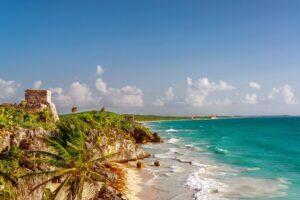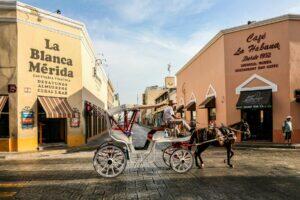Fodor's Expert Review Chichén Itzá
Little is known about those who founded this dramatic, 6-square-km (2¼-square-mile) metropolis. Some structures, likely built in the 5th century, predate the arrival of the Itzá, the people who occupied the city starting around the late 8th and early 9th centuries. Why they abandoned it in the early 1200s is also unknown, as is its subsequent role. What is known is that the city's name means "the mouth of the well of the Itzá," likely referring to the site's several cenotes—valuable sources of water.
Dominating Mexico's most stunning and well-preserved Maya site is El Castillo (The Castle), also known by its Mayan name, Kukulkán. The much-photographed pyramid is remarkable not only for its size, but also for its perfectly proportioned symmetry. Adorning the corners of its four stairways (no, climbing is not allowed) are open-jawed serpent statues that honor the priest-king Kukulcán (aka Quetzalcóatl), an incarnation of the feathered serpent god. More serpents appear... READ MORE
Little is known about those who founded this dramatic, 6-square-km (2¼-square-mile) metropolis. Some structures, likely built in the 5th century, predate the arrival of the Itzá, the people who occupied the city starting around the late 8th and early 9th centuries. Why they abandoned it in the early 1200s is also unknown, as is its subsequent role. What is known is that the city's name means "the mouth of the well of the Itzá," likely referring to the site's several cenotes—valuable sources of water.
Dominating Mexico's most stunning and well-preserved Maya site is El Castillo (The Castle), also known by its Mayan name, Kukulkán. The much-photographed pyramid is remarkable not only for its size, but also for its perfectly proportioned symmetry. Adorning the corners of its four stairways (no, climbing is not allowed) are open-jawed serpent statues that honor the priest-king Kukulcán (aka Quetzalcóatl), an incarnation of the feathered serpent god. More serpents appear in sculpted columns atop the building.
At the spring and fall equinoxes, the afternoon light strikes the pyramid so that the snake god's shadow appears to undulate down the side of it to bless the fertile earth. Thousands of people, from sightseers to shamans, travel here to witness this phenomenon. Make lodging reservations far in advance if you hope to join them.
Archaeologists are still abuzz about the 2015 discovery of a subterranean river flowing underneath the pyramid, detected via “electrical resistance survey.” Although the Maya would likely have intentionally constructed El Castillo over such a river cavern, there is concern that this will lead to the formation of a gigantic sinkhole that would threaten the structure’s foundation. Although experts say this would probably not happen for several generations, time will tell.
Just west of El Castillo is another highlight: the Anexo del Templo de los Jaguares (Annex to the Temple of the Jaguars), where bas-relief carvings represent still other important deities. To its west is the Juego de Pelota, the city's main ball court. Remarkably, if you stand at one end of it and whisper something, it will be heard all the way at the other end. The game played on this ball court was apparently something like soccer (no hands were used), but it likely had some sort of ritualistic significance. (Note that the Mérida tourist offices stages a popular demonstration of the ball game each Friday evening in front of the cathedral.)
On the other side of El Castillo, just before a small temple dedicated to the planet Venus, a ruined sacbé, or raised white road, leads to the Cenote Sagrado (Holy Well), which was probably for ritualistic purposes. The nearby Cenote Xtaloc was kept pristine, undoubtedly for bathing and drinking. Adjacent to it is a steam bath, outside of which is a tiny pool that was used for cooling down.
Older Maya structures lie south and west of Cenote Xtaloc. Archaeologists have been restoring several buildings in this area, including the Templo del Osario (Ossuary Temple), which concealed several tombs with skeletons and offerings. Behind the smaller Casa Roja (Red House) and Casa del Venado (House of the Deer) are the site's oldest structures, including El Caracol (The Snail), a round building—rare in Maya architecture—with an interior spiral staircase. With eight tiny windows precisely aligned with the points of the compass rose, it was seemingly built as a celestial observatory.
If the Maya gods are smiling, the evening sound-and-light show—which features images projected on El Castillo—won't be plagued by technical issues during your visit. Though some say the show is cheesy, others say it's stunning. Regardless, it offers a different perspective on this remarkable site. It takes place at 8 pm from April through October and at 7 pm the rest of the year. Reservations are required, and you can make them online ( nochesdekukulkan.com.mx) or through a tour operator. Tickets are pricey but include a 30-minute pre-show guided walk and use of a translation device (original narration is in Spanish only).
READ LESS





